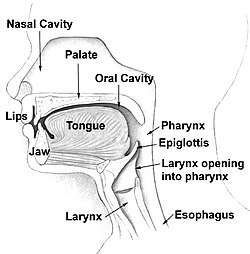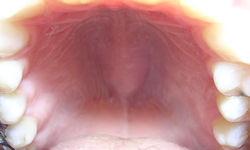Palate Structure and Development
- Consists of the hard palate and soft palate
- Hard palate forms before birth
- Development of the palate is a complex process involving fusion of tissues
- Genetic and environmental factors can influence palate development
- Abnormal palate development can lead to conditions such as cleft palate
Palate Innervation
- Innervated by the maxillary nerve branch of the trigeminal nerve
- Maxillary nerve branch of the trigeminal nerve supplies sensory innervation
- Nerve endings in the palate contribute to the sense of taste
- Innervation allows for the detection of temperature and texture in food
- Sensory information from the palate is transmitted to the brain via the trigeminal nerve
- Innervation of the palate is important for oral health and function
Variation and Cleft Palate
- Variation can result in a cleft palate
- Incomplete fusion of the palate can result in a cleft palate
- Cleft palate is a common congenital abnormality
- Cleft palate can affect speech, feeding, and dental health
- Surgical intervention is often required to correct cleft palate
- Early detection and intervention can improve outcomes for individuals with cleft palate
Palate Function in Humans
- Palate plays a crucial role in speech production
- Certain sounds, such as velar and palatal consonants, rely on the palate
- Palate also contributes to the articulation of postalveolar and uvular consonants
- Dysfunction of the palate can lead to speech disorders
- Palate's function in speech production is coordinated with other parts of the vocal tract
Palate's Role in Sensory Perception
- Nerve endings in the palate contribute to the sense of taste
- Innervation allows for the detection of temperature and texture in food
- Sensory information from the palate is transmitted to the brain via the trigeminal nerve
- Innervation of the palate is important for oral health and function
The palate (/ˈpælɪt/) is the roof of the mouth in humans and other mammals. It separates the oral cavity from the nasal cavity. A similar structure is found in crocodilians, but in most other tetrapods, the oral and nasal cavities are not truly separated. The palate is divided into two parts, the anterior, bony hard palate and the posterior, fleshy soft palate (or velum).
| Palate | |
|---|---|
 Head and neck. | |
 Palate exhibiting torus palatinus | |
| Details | |
| Identifiers | |
| Latin | Palatum |
| MeSH | D010159 |
| TA98 | A05.1.01.102 |
| TA2 | 2778 |
| FMA | 54549 |
| Anatomical terminology | |